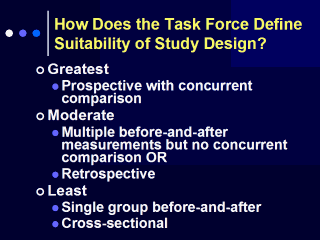| front |1 |2 |3 |4 |5 |6 |7 |8 |9 |10 |11 |12 |13 |14 |15 |16 |17 |18 |19 |20 |21 |22 |23 |24 |25 |26 |27 |review |
 |
To assess
effectiveness, the Task Force requires that study designs include some kind
of concurrent or before-and-after comparison. Studies are then categorized
into three groups, according to their design. Those with the greatest suitability for evaluating effectiveness of an intervention: these are prospective studies with concurrent comparison groups, such as randomized and non-randomized trials or prospective cohort studies. Designs with moderate suitability for evaluating effectiveness include those with multiple measurements over time but no concurrent comparison group, or any retrospective studies. Finally, designs that include only single measurements before and after the intervention or cross-sectional designs are considered to be least suitable but are still typically included in Community Guide reviews. Study design is important, but itís not the only aspect of a study that needs to be assessed. The Task Force also assesses how well the study was executed, given the design used. |